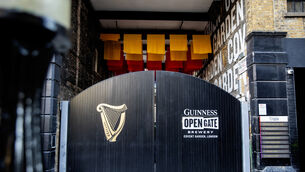Raising concerns: How a sex offender was able to stay working with young people

Questions linger over how former Christian brother Edward Bryan, jailed last month for sexual offences, remained working with young offenders for so long — and whether the matter should have been handled differently, writes

Edward Bryan has been described as friendly, affable, enigmatic. He has been a teacher, a chaplain, a Christian Brother.

He has also been convicted three times of historic sex offences against boys while teaching in Cork.
For 15 years he worked with young offenders in Dublin, for much of that period as deputy director of what was the precursor to Oberstown Children Detention Campus.
Bryan, now 67, was jailed again just a fortnight ago after pleading guilty to the indecent assault of a 14-year-old while working as a teacher in the North Monastery secondary school in Cork.
And yet here was a man who, while deputy director at what became the Finglas Child and Adolescent Centre in Dublin 11 between 1994 and 2010, was the subject of concerns over his behaviour.
He was suspended twice, and both times brought his employers to court and returned to work, in what an unpublished report — commissioned by the Department of Children and Youth Affairs and the Irish Youth Justice Service and a summary of which has been seen by the Irish Examiner —described as a process riddled with delays and mistakes, exposing weaknesses in the system as it operated then, and fears that a similar scenario could arise again.
In early 2013, Bryan, with no previous convictions, was sentenced to five years in jail for indecently assaulting three boys at the North Mon in the 1980s.
At that trial, Bryan said of the charges: “I deny it emphatically.”
When the prosecution put it to him that if the allegations were untrue, as he maintained, then he must feel like the unluckiest man in Ireland, Bryan replied: “I certainly feel that way.”
The court had heard from gardaí that the nature of the abuse included getting boys to strip naked, sometimes climbing on their backs and ejaculating.
One victim told the court: “On a number of occasions, I sat in my car outside various Garda stations in Cork and just cried. To have to go through all the graphic detail of what was done to me was something I wouldn’t want anyone to have to do. But I did it and if it took 20 trials and 100 hours in the witness box I would still do it.”
Another said: “It has been haunting me for 23 years.”
Bryan was sentenced by Judge Seán Ó Donnabháin, who observed: “There is no shred of remorse in this, not a shred of remorse.”
In mid-2015, Bryan was returned to jail following an unsuccessful appeal against the 2013 convictions. At that time, the court was told that Bryan was prepared to take up any available rehabilitative courses for sex offenders.
Then in July 2015, Bryan was sentenced to a year in prison after pleading guilty to sex assaults on two other pupils in the North Mon.
The victims were teenagers and were being coached after school in sports when the crimes were committed.
One of the victims said: “I suppose I would say that you have stolen a moment of my life that I can never have back and will always have a resounding effect on my life.”
At that hearing, Bryan’s defence barrister said he had been instructed to apologise profusely to the victims, as well as to his own family and to the Christian Brothers for any disrepute he had brought on them. Judge Ó Donnabháin welcomed what he said was Bryan’s substantial change of heart and declared: “The victims are vindicated.”
The court had heard a month previously that Bryan had made anattempt on his life at his address in Trim, Co Meath.
Just two weeks ago came the latest jail sentence, yet again for an offence dating back to his time in the North Mon.
Bryan, now 67, pleaded guilty to having indecently assaulted a 14-year-old boy at the secondary school in Cork in 1981 after picking him out to meet for basketball training. Bryan, now with an address at Dugort, Achill Island in Co Mayo, was jailed for one year.
The victim told the court he gave up sport because after the incident he could not face being in a changing room with others.
In his victim impact statement he said: “I later had to sit in that very hall and do my Intermediate Certificate Exam. I froze with fear and nervousness and feeling sick in my stomach.
“Needless to say, I failed my exam. I sat there looking at the clock on the wall, the minutes ticking by — the same clock that was on the wall when Brother Bryan had me on the ground and he was on my back sexually abusing me.”
Documentation received by the Irish Examiner under Freedom of Information shows Bryan’s rapid progress at the Finglas Child and Adolescent facility in the mid-1990s.
He was first appointed as a teacher to St Laurence’s in Finglas in August 1994, having left the brothers. By November 1995, the board unanimously decided to recommend Edward Martin Bryan for the job of deputy director there.
The appointment was confirmed by a letter sent by Michael Donnellan to the Special Education section in Athlone on December 27, 1995.
Bryan, in his letter of acceptance of December 19, 1995, wrote to Donnellan — who went on to become director general of the Irish Prison Service and who left the Finglas facility not long after Bryan joined — “assuring you of my best efforts on behalf of the centre”.
Also included in the FOI documents are the questions asked during thedeputy director interviews onNovember 11, 1995, among them: “Why is it important for a centre such as ours to have a clear written child protection policy?”
By the turn of the millennium, the Finglas campus — made up of St Laurence’s Special School, St Michael’s Assessment and Remand Centre, and the Grove Pre-Release Unit — was not a happy place.
In April 2002, five care staff locked themselves into a room after six teenagers broke out from their dormitory, smashing their way through a window and climbing to the top of a two-storey building.
In June the following year, three 14-year-old boys were charged with causing damage costing €10,000 after they barricaded themselves into a room. In March 2003, the Dáil heard that Finglas children’s centre had gone, in the space of four years, from a centre of excellence into ongoing crisis, with constant reports of riots, assaults,absconders, ad-hoc planning, high staff turnover, low bed-occupancy,threatened industrial action, and escalating annual budgets.
An inspection report published in July 2002 found: “It is evident and undeniable that the organisation is in acute crisis. It lacks clear direction; it is not meeting a number of basic requirements.” It added: “It is not safe for young people and staff.”
In the middle of all this, concerns were raised regarding the behaviour of Edward Bryan, so much so that he was suspended, first in 2002.
On July 22 that year, Bryan launched a legal action against the board of the Finglas centre, and others, including the minister of education and the attorney general.
The action was adjourned multiple times until an order was delivered — ‘Chancery Action (settled) Final’ — in May 2004.
The Irish Examiner understands that Bryan went back to work, despite continuing misgivings on the part of some staff. It is also understood he was suspended for a second time.
He launched a legal action as plaintiff against the HSE in July 2005, when an ex parte judicial review was granted, followed in November of that year by a judicial review certiorari final.
It appears he had twice successfully fended off disciplinary proceedings, and even returned to his position of designated child protection officer.
In February 2013, in a letter to Tony O’Donovan, child welfare officer in the Irish Youth Justice Service, the then-inspector manager of Hiqa, Patrick Bergin, referred to Bryan’s recent conviction: “Considering the recent conviction and positions that Mr Bryan held in the detention school facilities, the authority are seeking clarification if any actions/assessments were or are planned to be undertaken by the detention schools in conjunction with the HSE to determine if any children were exposed to abuse by Mr Bryan during his tenure in the facilities.
There was action. A report commissioned by the Department of Children and Youth Affairs and the Irish Youth Justice Service (IYJS) was conducted by Kieran McGrath, a noted child welfare consultant, and finalised in 2014.
The summary version of that report, seen by the Irish Examiner, refers to “a former member of staff of a Children Detention School and the historic offences which occurred prior to his employment there”.
That man is Edward Bryan and the report states: “This person held a management position within the organisation and during a period of c 15 years ‘concerns’ had been raised at various times. The catalogue ofconcerns culminated in the staff member being placed on administrative leave pending further investigation.
“The investigative process extended over a protracted period of time, which resulted in the High Court ordering that the suspension be lifted. Some six years later the employer was informed of allegation [sic] relating to a period prior to taking up his present employment.” It adds that Bryan was placed on administrative leave at that point.
Among the questions asked by the report was what knowledge existed that someone who worked in a child care setting, and who was later proven to have sexually abused, had posed a threat to children. It also asked what protocols existed for professionals working alongside him at the time, and whether actions taken were reasonable in the circumstances.
On the protocols, it said managers and staff needed to have “appropriate awareness and confidence to deal with concerns/complaints” and added: “Where there is no clear-cut allegation, just a series of concerns, then the concept of grooming behaviour must be considered.”
It said staff needed to familiarise themselves with the six stages of ‘grooming behaviour’ and as to legal opinion, it said: “The over-reliance on the legal point of view and the path that had to be followed having received it precluded the scope to look at the concerns/complaints from a wider child welfare and/or performance review perspective.
“Any future investigation should be twin-pronged, with the legal and child welfare aspects taken on board.”
It also referred to professional accommodation syndrome “to explain how frontline professionals sometimes develop unhealthy coping mechanisms in response to the stress of dealing with child welfare work” and the need for transparency and fair procedure.
The report also refers to returning staff and how it can be acceptable for their own protection to ask them not to perform certain tasks or fulfil certain roles and that this implies no guilt or slur on their character.
As for close supervision, it said “that in such a case of a returning staff member while the investigation into the specific incidents/complaints was over a centre or management of a centre need not adopt a type of ‘institutional amnesia’ for fear of falling foul of a court order. Management have room to limit access to children; to put in place safety measures; and alter functions that could be presented as being for the staff member’s own protection”.
The report went on: “The grooming aspect was only dealt with in an implicit rather than an explicit manner.”
It said staff found it difficult to stand over their concerns due to professional accommodation syndrome and that “the amount of time and energy devoted to the micro-management of this case by the department was unnecessary and unhelpful”.
“By involving legal advice from the AG’s office the process was slowed down, which created delay and confusion. This was compounded by the numerous number of staff changes during the period.
“The review found that no one person had a firm grip of the matter and this led to the confusion and delays.
“The plethora of delays is a striking feature throughout the case,” it said. “Delay is the enemy of both sound child safeguarding practice and fair procedure.”
The review also said that where control of the process is handed to the HR department, which is more removed from day-to-day practice, “it is much easier for the process to become overly legalistic and/or suffer very long delays”.
The report likens the situation to that on an oil rig — “On an oil rig, every member of staff is instructed to feel free to bring ANY safety concern to the crew’s attention, even to the highest ranking member of staff, if designated safety officers don’t take their concerns seriously enough.”
The report cited a number of weaknesses “that existed in the past”, including:
Failing to correctly identify the dynamics of sexual abuse, in particular the way in which certain sex offenders ‘groom’ their victims, prior to actually abusing them;
The process was allowed to get bogged down in a series of legalities that ultimately were both counter-productive and extremely costly to the State;
Over-reliance on legal advice;
A reliance on the Attorney General’s Office in deciding how a case should be dealt with.
The report added: “Allowing a staff [member] to resume the role of designated child protection officer was a mistake in the reviewer’s view, but this may have been influenced by a belief that the outcome of the legal proceedings had been so negative that no attempt should be made to curb the role in any way, lest it trigger further litigation.
“A far better approach, in the reviewer’s view, would have been to have kept the matter out of disciplinary proceedings, given the history of having ‘previously dealt with’ most of the complaints against the person, if that was not possible.”
It added that the matter could have been reviewed under a performance review or practice development.
The report concluded: “The reviewer would argue that weaknesses still exist within current guidance in that the examination of cases where allegations [are made] against persons in positions of trust, teachers and others, is frequently very drawn-out, with a lack of clarity among management.”
“In terms of the future, the reviewer is of the view that another scenario similar to the case reviewed could arise. This is not wholly preventable, given how devious some sex offenders can be.”
DURING some of those recent court dates, Bryan was accompanied by a friend and blended into the busy courtroom on Anglesea St in Cork.
He looked younger than his years, wearing a wine-coloured jacket and thick glasses.
He was returned to prison without ceremony, and yet it was hard to imagine that somehow he was, as he said back in 2013, the unluckiest man in the world.
Sentencing Judge Bryan O’Callaghan referred to Bryan’s “no doubt genuine” apology and said: “As well as destroying the life of this victim, your own life has been destroyed and your reputation, which is only as it should be.”
And he said: “The court must not forget who the victim is.”















